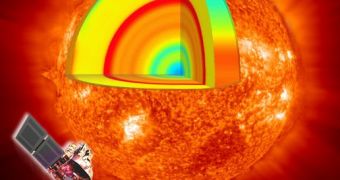Institute for Corpuscular Physics (IFIC) researchers along with other European groups have focused on the effects of the existence of dark matter in the Sun, and according to their calculations, particles of dark matter could transfer energy from the core to the exterior of the Sun, which could influence the amount of neutrinos that reach our planet.
All astrophysical observations seem to indicate that our galaxy is situated in a halo of dark matter particles, and it is believed that most of the dark matter particles come together in the Sun's center, but since they have an elliptic orbit, they must reach other parts of the star as well, where they interact and exchange with the solar atoms.
This is actually the way that the Weakly Interacting Massive Particles, or WIMPs, carry the energy from the extremely hot central core to the cooler extremities.
Marco Taoso, researcher at the IFIC, a combined center of the Spanish National Research Council and the University of Valencia, explains to SINC that “this effect produces a cooling down of the core, the region from where the neutrinos originate due to the nuclear reactions of the Sun.
“And this corresponds to a reduction in the flux of solar neutrinos, since these depend greatly on the temperature of the core.”
There are several techniques that allow measurements of the neutrinos that reach the Earth, and the obtained data can be used to see the changes in the Sun's temperature, caused by the WIMPs.
How much energy these particles transport depends on their odds of interacting with atoms, and also on the 'size' of the interactions, which is linked to the reduction in the neutrino flux.
Taoso explains that “as a result, current data about solar neutrinos can be used to put limits on the extent of the interactions between dark matter and atoms, and using numerical codes we have proved that certain values correspond to a reduction in the flux of solar neutrinos and clash with the measurements.”
According to the models, ”when the WIMPs pass through the Sun they can break up the atoms of our star and lose energy.
“This prevents them from escaping the gravitational force of the Sun which captures them, and they become trapped, orbiting inside it, with no way of escaping”, the researcher emphasizes.
“We assume that the dark matter particles interact weakly with the Sun's atoms, and what we have done is calculate at what level these interactions can occur, in order to better describe the structure and evolution of the Sun", added Taoso.
This study was recently published in the journal Physical Review D, AlphaGalileo reports.

 14 DAY TRIAL //
14 DAY TRIAL //